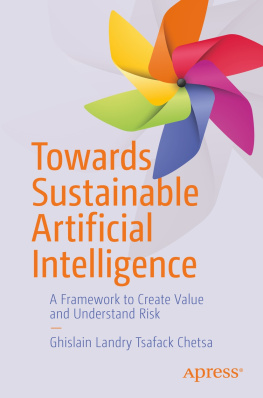Ghislain Landry Tsafack Chetsa - A Framework to Create Value and Understand Risk
Here you can read online Ghislain Landry Tsafack Chetsa - A Framework to Create Value and Understand Risk full text of the book (entire story) in english for free. Download pdf and epub, get meaning, cover and reviews about this ebook. year: 2021, publisher: Apress, genre: Romance novel. Description of the work, (preface) as well as reviews are available. Best literature library LitArk.com created for fans of good reading and offers a wide selection of genres:
Romance novel
Science fiction
Adventure
Detective
Science
History
Home and family
Prose
Art
Politics
Computer
Non-fiction
Religion
Business
Children
Humor
Choose a favorite category and find really read worthwhile books. Enjoy immersion in the world of imagination, feel the emotions of the characters or learn something new for yourself, make an fascinating discovery.
- Book:A Framework to Create Value and Understand Risk
- Author:
- Publisher:Apress
- Genre:
- Year:2021
- Rating:3 / 5
- Favourites:Add to favourites
- Your mark:
- 60
- 1
- 2
- 3
- 4
- 5
A Framework to Create Value and Understand Risk: summary, description and annotation
We offer to read an annotation, description, summary or preface (depends on what the author of the book "A Framework to Create Value and Understand Risk" wrote himself). If you haven't found the necessary information about the book — write in the comments, we will try to find it.
A Framework to Create Value and Understand Risk — read online for free the complete book (whole text) full work
Below is the text of the book, divided by pages. System saving the place of the last page read, allows you to conveniently read the book "A Framework to Create Value and Understand Risk" online for free, without having to search again every time where you left off. Put a bookmark, and you can go to the page where you finished reading at any time.
Font size:
Interval:
Bookmark:


This Apress imprint is published by the registered company APress Media, LLC part of Springer Nature.
The registered company address is: 1 New York Plaza, New York, NY 10004, U.S.A.
To my family Valerie and Adlynne, and my sister Bertine.
Artificial intelligence (AI) by now infiltrates various aspects of daily life. While some are skeptical of its potential, others believe AI can provide fast and effective approaches for addressing a wide range of problems: from policing and crime prevention to personalized healthcare or streamlining the judiciary system. This is a belief which is likely motivated by the successful application of AI in industries such as the retail and the manufacturing industries. It is, therefore, not surprising that many organizations, including public institutions, are trying to adopt AI and related technologies in some shape or form.
It should, however, not be surprising that adopting a technology that has as much potential as AI generally requires many more inputs than the technology itself. In other words, recruiting data-related professionals or experts and having them develop AI systems for an organization is unlikely to be sufficient to meet all its objectives.
In fact, we observed a similar trend with the advent of the Internet.
With the use of the Internet increasing throughout the 21st century, users have increasingly been subject to abusive practices such as unwanted commercial emails (spam), identity theft, and more recently user tracking. Experts have responded to and mitigated some of these through technical solutions, while regulators and governments have stepped in to prohibit certain practices. In some cases, it is now required that organizations inform their users of their practices in advance. Importantly, we as users expect organizations that we interact with online to mitigate our exposure to abusive practices. This means that from an organizations perspective, simply creating an online presence is probably not the biggest challenge. The real complexity lies in understanding the following questions: What are the greatest potential challenges, and are they addressed adequately? How is the potential return on investment in building an online presence impacted by such challenges? What is the impact of the online presence on my organizations ability to create value in the short, medium, and long term? In essence, organizations need to invest to understand and manage the risk around their online presence.
Investing in AI is not so different: Successfully developing AI systems that meet the constantly changing needs of todays society requires a holistic, methodical, and adaptive approach designed to assess and manage the risks around introducing AI. Such an approach should ensure that AI systems developed by an organization are aligned with its way of conducting business and meet certain social standards. The increasing importance of principles such as fairness, privacy, and social equality in discussions around AI corroborates the importance of this. Failing to meet those standards can result in lost opportunities for an organization. Worse yet, it may even lead to an organizations demise.
Preventing or managing the social, political, and economic challenges that organizations wishing to develop and/or deploy sustainable AI systems may face today is of great importance. We understand sustainable AI systems to be those that manage to incorporate both business and human values and principles in their design. Potential challenges include, for example, an AI systems need to remain consistent with the companys as well as human principles to be truly effective and/or remain flexible to adjust to new regulations imposing alignment with such social standards. While it is often easy to identify a problem once it has happened, making sure that similar problems do not arise in the future is challenging because it requires a methodical approach involving all stakeholders.
This book discusses the concept of sustainability in AI. To help businesses achieve the objective of developing sustainable AI systems, this book introduces the sustainable artificial intelligence framework (SAIF). This is designed to help organizations create value and understand risks when adopting and/or developing AI systems.
The challenges addressed in this book are of interest not only to mainstream adopters of AI but also to organizations seeking to improve their efficiency through AI.
The primary audience for this book is decision makers in organizations wishing to deploy AI systems. This includes government officials, members of the C-suite or other business managers, data scientists, as well as any technology experts aspiring to a data-related leadership role. While the book refers to the technical aspects of AI in places, sufficient context is provided whenever needed to facilitate understanding. As a result, the reader is not required to have a deep background knowledge of AI to understand the key concepts of the methodology discussed in this book; a basic training in statistical methods should be sufficient. This being said, readers with some knowledge of AI may find the book more accessible.
How to develop and deploy AI systems that meet certain social standards and principles
Font size:
Interval:
Bookmark:
Similar books «A Framework to Create Value and Understand Risk»
Look at similar books to A Framework to Create Value and Understand Risk. We have selected literature similar in name and meaning in the hope of providing readers with more options to find new, interesting, not yet read works.
Discussion, reviews of the book A Framework to Create Value and Understand Risk and just readers' own opinions. Leave your comments, write what you think about the work, its meaning or the main characters. Specify what exactly you liked and what you didn't like, and why you think so.











